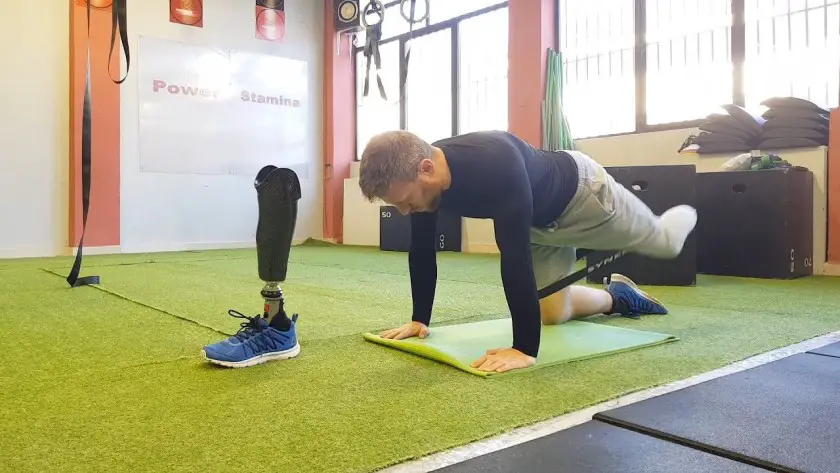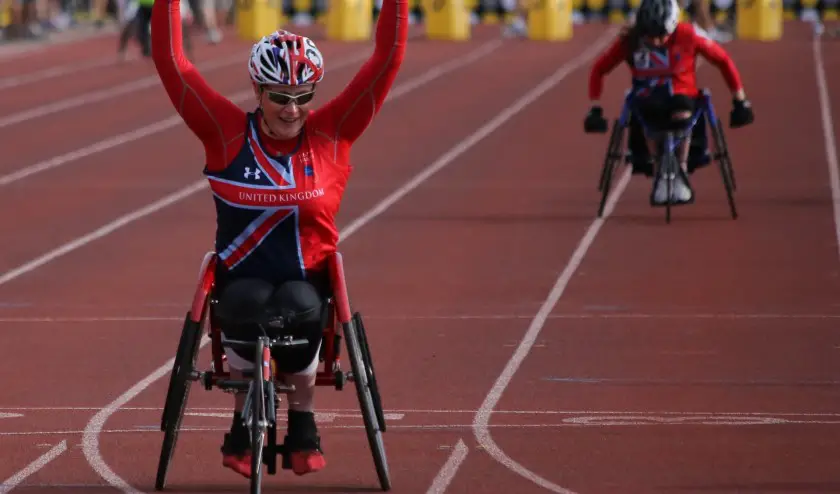Building a strong core is very important for you as an amputee.
Your core is your center of gravity and where all your power comes from.
It is fundamental in everything locomotion.
And is the point for the generation of power, stability, and balance.
As such, strengthening your core is crucial and should be a regular routine in your workout schedule.
Table of Contents
- What Is the Core?
- 15 Core Strengthening Exercises for Amputees
What Is the Core?
The core is everything else aside from your limbs, neck, and head.
Most people think their core is only their abdomen. But the core is much more than the abdomen.
The core consists of the abdominal, hip, back, and butt muscles.
These all consist of sectional muscles that can be exercised individually or in synchrony.
Exercising your core muscles after amputation is crucial to your well-being and look.
Having a strong core gives you more power to easily move your body or move things and increase your stability on your prosthetics.
And you also get to look better with well-sculpted abs.
Include these 15 core strengthening exercises in your next workout routine and you’ll find yourself getting stronger and more stable.
15 Core Strengthening Exercises for Amputees
Having amputated limbs can be overwhelming but then life happens and we don’t get to be choosers sometimes.
But we can control a lot of things about ourselves, especially our forms and strengths.
Below are the top core strengthening exercises to boost your energy while getting ripped.
1. Hollow man
The hollow man is a powerful core strengthening exercise that can train your quads, hip flexors, inner thighs, erector spinae, and rectus abdominis muscles.
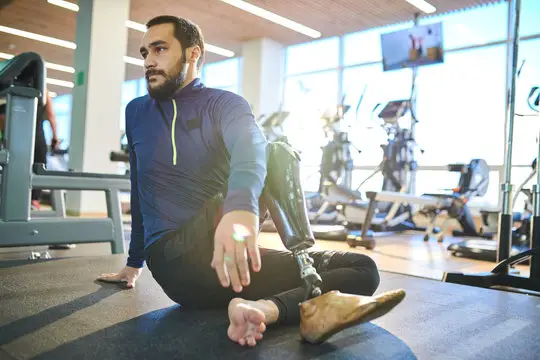
How to:
Lie on your back with your legs extended and your hands extended by your side but over your head.
To work your abdominal muscles, try lifting your arms, head, shoulder, and legs off the ground at the same time. Hold the position for a few seconds and then return to your original position.
Repeat the movement again.
Related: 4 Traumatic Examples of Disability Discrimination in Sport
2. Abdominal crunches
The abdominal crunch is a powerful exercise for strengthening your stomach muscles.
It is ideal for lower limb amputees with prosthetics. It can also be modified for those without prosthetics.
How to:
Lie on your back with your knees slightly bent.
Ensure that the bent knees form a triangular space between prosthetic legs and your hips. If without prosthetic legs, then ensure that your hips rest on the floor.
Now, stretch forth your arms forward with your palms facing downward and then lift your upper body off the floor.
Hold it in that position for a few seconds and then slowly return your back to the floor again. Repeat this 10x, 12x, 16x, or as much as you can go.
Take a break and then repeat.
This exercise primarily strengthens the rectus abdominis muscle and the oblique muscles.
3. Russian twist
The Russian twist is an ideal exercise for amputees in all categories.
You can vary it without your prosthetic legs and you can also vary it to accommodate your needs without hands.
How to:
To perform the Russian Twist, sit on the floor with your knees bent and your prosthetic feet raised a little above the floor.
Now, tilt your back a little backward.
Think of this as forming a zig-zag shape. Your head, neck, and trunk will form the first vertical slash, your hips will form the second diagonal slash, and your legs will form the other vertical slash.
After getting into that position, clasp your hands together in front of your chest and then try to twist your trunk from around the shoulder from side to side.
Repeat this up to 20x, rest, and repeat.
If you’re not with your prosthetics, then you can easily perform this exercise by letting your hips rest on the floor instead of having them raised.
This exercise is also great for those with amputated hands. Twist your shoulders from side to side without clasping your hands while in the position.
4. Plank
The plank is one of the most popular recommended exercises for core strengthening.
How to:
Performing the plank move is quite easy.
Imagine yourself lying down with your belly on the floor. Then imagine raising your body in that position such that you are on your toes and your forearms are pressed down to support your weight.
That position is the plank.
To get into the plank position, lie on the floor with your toes and forearms on the ground. Slightly raise your body such that only the toe and the forearms remain in contact with the floor.
Remain in that position for as long as you can and then slowly return the rest of the body to the ground for rest. Time yourself and repeat the process as many times as you want.
You can do this with the toes of your prosthetics or by lying down in such a way that your hips maintain contact with the floor.
This exercise strengthens the stomach, abdominal, shoulder, and back muscles.
5. Abdominal bracing
This core strengthening exercise involves the use of a ball and a wheelchair. You can as well use a regular chair for this.
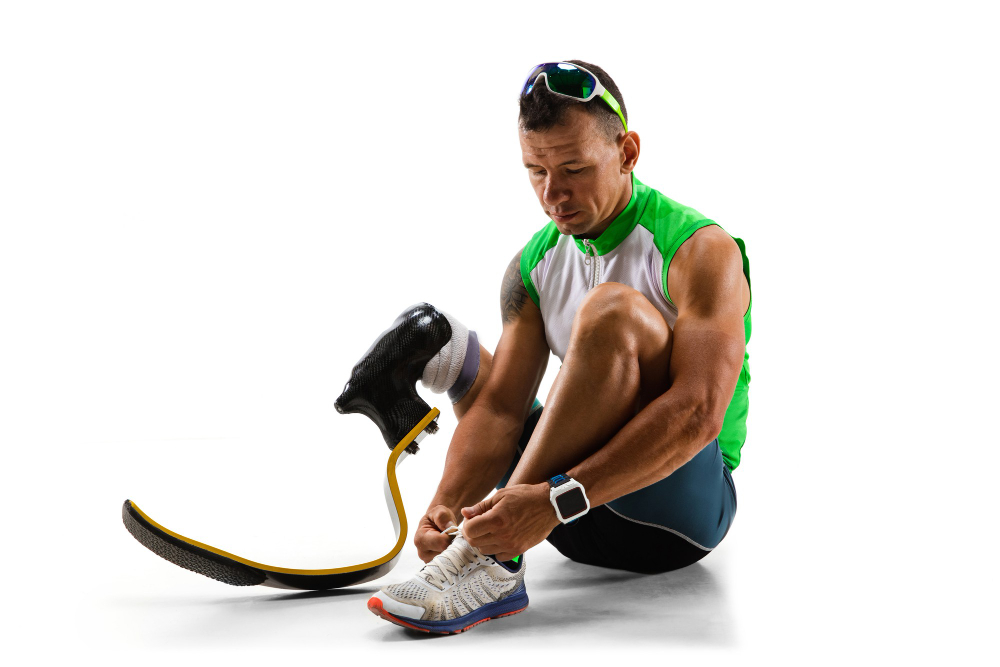
How to:
Sit up in a chair or your wheelchair and hold a ball between your knees.
Brace your abdominal muscles as hard as you can so as to squeeze the ball.
You can repeat this a few times until you’re tired. The aim of this exercise is to increase the strength of your stomach muscles.
6. Heel touch
The heel touch stretches and strengthens your abdominal muscles. This is one of the very few exercises that focus on stretching the abdominal muscles to increase your core strength.
How to:
Start by laying on the ground with your legs (or prosthetics) bent at the knee and with the knees facing up and your hands by your side.
Slightly lift your upper body off the floor and try to reach for your heel with your right hand. Return to the position and then try reaching for your heel again with your left hand.
7. Crossover crunch
The crossover crunch aims to tighten your abdominal muscles and make them stronger. It also stretches your shoulder and back muscles.
As such, it can be very tasking to perform for long.
How to:
Get into position by laying on your back with your leg bent at the knees and your hands behind your ears.
Raise and twist your torso such that your left elbow moves to meet your right knee as the knee moves upward towards your chest.
Do the same for the left elbow and right knee. Repeat the alternate movement until you’re tired.
Rest and then try again a few times.
Related: Painful Examples of Disability Discrimination in Sport
8. Cobra stretch
The cobra stretch helps you to maintain your upright posture in spite of your missing limbs. This exercise is best for those with lower limb amputation.
How to:
Lie on your stomach. Then raise your upper body from the front in such a way that your hands support the full weight of your body while the legs are fully stretched out.
Your chest region to your stomach should be above the floor while the region from your groin to the legs rests comfortably on the floor.
Push your chest up and off from the ground as far as possible. Hold the position for as long as you can.
9. Butt bridge
The butt bridge is perfect for any amputee and a great workout to strengthen your core muscles.
How to:
Lie on your back with your legs bent at the knee. Ensure that your feet are flat on the floor, then rest your hands flat at your sides.
Try lifting your butt up and down in that position. Repeat the up and down movement a few times until you become exhausted.
10. Seated in and outs
You will need a good bench to perform this workout on.
How to:
Sit on a bench and slightly lean your back a little as you would recline on a chair with a recliner.
As you tilt your back, put your hands behind your back and grab the bench with both hands.
Lift your legs such that only your butt remains on the chair.
As you lift your legs from the ground, bring your knees towards your chest by bending your legs at the knee, then fully extend your leg by straightening it.
Repeat this by bending your legs at the knees to move them closer to your chest and then straightening your legs again.
11. Leg Raises
Leg raise is a simple workout routine that can help burn fat around your abdominal region and keep your abs well sculpted.
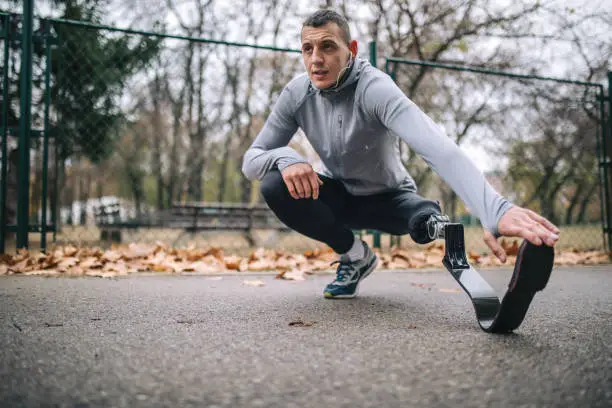
How to:
Lie down on your back with your legs close to each other and stretched out without bending at the knees.
Put each of your hands beneath your hips. This will provide support for the leg movement.
When in position, lift your legs up such that your leg is perpendicular to the floor and then slowly bring them down so that they are in line with your body again.
Repeat the movement a few more times.
12. Bent leg twist
This exercise is quite tasking but excellent for burning abdominal fat.
How to:
Lie on your back with your hips and legs raised from the ground.
Now, bring your knees forward towards your groin region such that the knee is at an angle of 90 degrees to your trunk.
Spread out your arms to the side with your palms facing the floor.
Twist your legs to the right without moving your upper body and with your knees and feet held together.
Hold the position for a few seconds and then twist the legs to the left. Hold and repeat.
13. Scissors
Scissors is a great workout routine to exercise your oblique and rectus abdominis muscles.
How to:
Lie on your back with your hands resting on your side, palms facing the floor, and your legs stretched out and held together.
Raise your legs such that they form a right angle with your upper body. While in this position, cross your right thigh over your left thigh like you would cross your legs when sitting down.
But this time don’t bend your legs at the knee and make sure your back is always flat on the floor.
Repeat the leg-crossing using the left thigh to cross over the right one.
14. Plank jack
This is a modified plank workout.
How to:
Start in a straight regular plank position as discussed earlier. Hop your feet apart and then bring them back together.
15. Reverse crunches
This is a crunch workout but in the reverse
How to:
Lie on your back and then raise your knees such that they are at 90 degrees to your upper body. Keep the knees together and place your hands behind your head.
Lift your upper body and thighs at the same time, with your elbows touching or coming near your knees. Then stretch out by lying slowly on your back.
Repeat this a few times.
